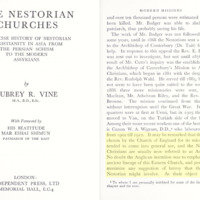-
Title
-
The Nestorian Churches: A Concise History of Nestorian Christianity in Asia From the Persian Schism to the Modern Assyrians
-
Creator
-
Aubrey R. Vine
-
Date
-
1978
-
Description
-
Aubrey R. Vine writes that British contact with the East Syriac Nestorians quickened after C. J. Rich’s encounters near Nineveh in the 1820s. Rev. Joseph Wolff carried a Syriac New Testament to England, and the British and Foreign Bible Society printed and distributed it around Urmi in 1827, while European governments protested after Kurdish attacks in 1830. The American Presbyterians opened a long mission at Urmi, while the Church of England worked through the SPCK, sending Ainsworth and later George Percy Badger, who earned goodwill by offering aid without trying to change doctrine and who sheltered the patriarch during the 1842 massacres. After the Nestorians appealed to Archbishop Tait in 1868, E. L. Cutts’s inquiry led to the Archbishop of Canterbury’s Mission to the Assyrian Christians in 1881, staffed by Rudolph Wahl, later Canon Maclean, Athelstan Riley, W. H. Browne, and finally Canon W. A. Wigram. The mission lasted until the Great War and moved its headquarters from Urmi to Van in 1903.
Vine explains that late 19th century Anglicans deliberately adopted “Assyrian” as the title for their mission among the East Syriac Nestorians. The Archbishop of Canterbury’s Mission used it in reports, school charters, and correspondence, and the term soon spread into wider English usage, so that newspapers, missionary journals, and general readers spoke of Assyrian Christians rather than Nestorians. The choice was both strategic and pastoral: it emphasized the community’s rootedness in the old Assyrian heartland, and it avoided the polemical associations of “Nestorian,” a term long tied to heresy and theological controversy. The new name also gave the community a dignified ethnonym that Western audiences could respect, while allowing Anglicans to support and reform the church without reopening ancient doctrinal debates.
Vine further notes that the community did not historically call itself Assyrian. In earlier Greek, Latin, and Western sources it was very often referred to as the Persian Church, because its catholicoi resided at Seleucia-Ctesiphon in the Sasanian Persian Empire, and its jurisdictions extended deep into Persia and beyond. Its own traditional title was the Church of the East, using the East Syriac rite and language. In Vine’s account, therefore, “Assyrian” was a modern, mission-driven designation, introduced and popularized by Anglicans, which gained legitimacy through long usage and was later embraced by many within the community itself, culminating in the modern name Assyrian Church of the East.
-
Language
-
English
-
Publisher
-
The Nestorian Churches: A Concise History of Nestorian Christianity in Asia From the Persian Schism to the Modern Assyrians, 1978, Aubrey R. Vine, p. 170–194.
-
archive.org
 image (1).png
image (1).png 
